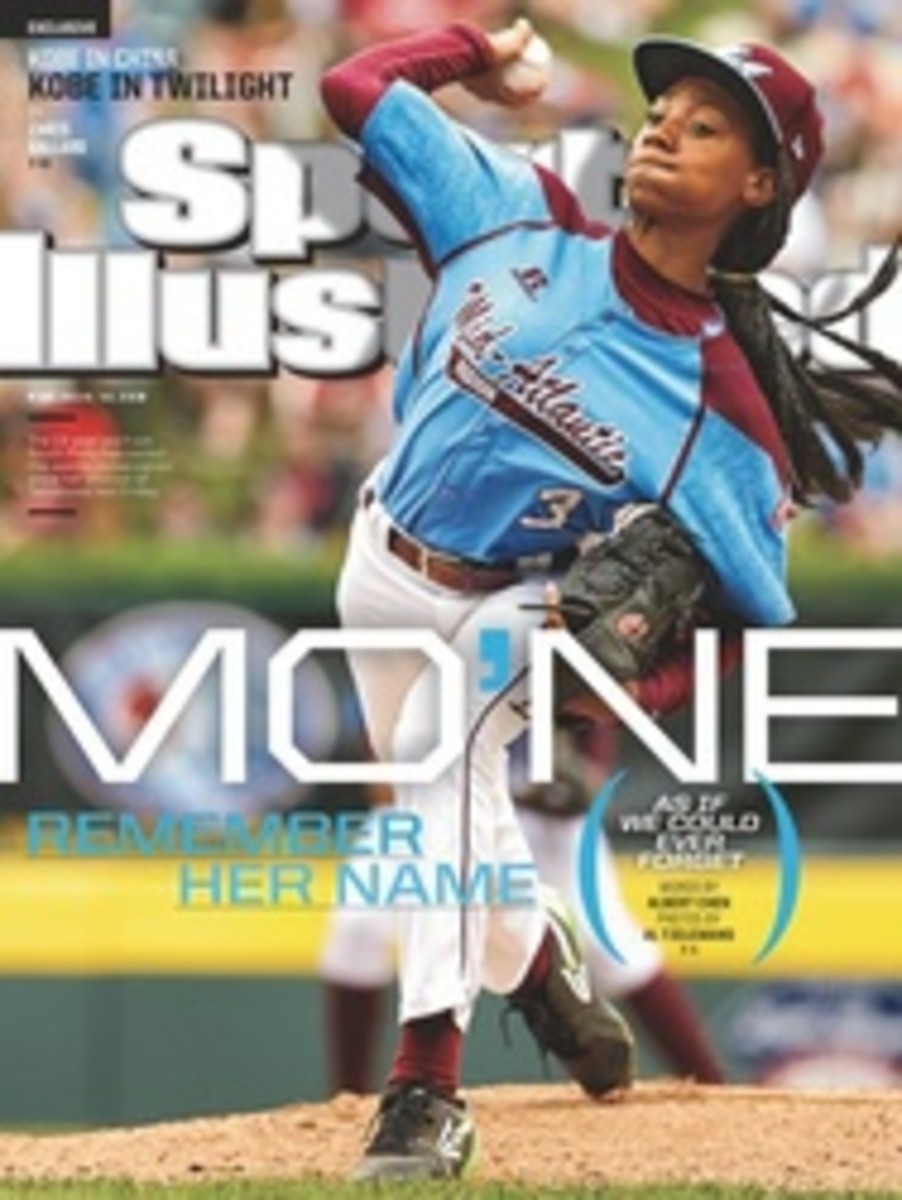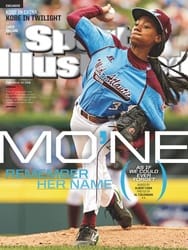
IT WAS ONLY A MATTER OF TIME
THE END HAS come far too early for the Royals in each of the past 28 seasons, and this year it seemed to arrive on July 31. The nonwaiver trade deadline passed that afternoon, and the Tigers—Kansas City's intradivisional tormentors, who as usual had a healthy lead, of five games—added lefty David Price to their rotation of Cy Young Award winners just before the stroke of 3 p.m. CDT. The Royals had engaged in talks for Price and others, and acquired no one. That evening, X-rays revealed a stress fracture in the right hand of first baseman Eric Hosmer, seeming to compound the effects of the broken club's inaction.
"This was the time for the Royals to make a choice," blogged Joe Posnanski, the former Kansas City Star columnist (and SI senior writer) who has become the Robert A. Caro of the club's path to powerlessness. "They needed to be buyers. They needed to be sellers. They needed to be SOMETHING. And instead, like it has been for most of the last quarter century, they were nothing. And that is hard to take."
So what happened next came as a shock to a fan base that long ago became accustomed to residing not just in the states of Kansas and Missouri but also a state of misery. The Royals, who since their championship run in 1985 have failed to reach the playoffs while losing more games than any other franchise, have refused to stop winning. After finishing July by taking seven of nine, they began August by going 13--3. They were beating good teams, too, winning five of seven from the A's—owners of baseball's best record—and sweeping the Giants, who are in playoff position in the NL. On Aug. 11 they tracked down Detroit to take over first place in the AL Central. Nothing, all of a sudden, had become something.
Theories abound as to the source of the Royals' reversal of fortune. There is the inspiration theory, which holds that by standing pat at the deadline, the front office empowered its players to take matters into their own hands. "It gave us a self-confidence, yeah," says the team's best player, leftfielder Alex Gordon, a semibeliever.
There is the far more entertaining SungWoo theory, which relates to the first trip to Kauffman Stadium of SungWoo Lee, an excitable 38-year-old South Korean who picked the Royals as his team nearly two decades ago and has passionately followed them ever since, often in the middle of the night in Seoul. SungWoo was treated not as a visiting merchandise manager, but as a visiting monarch. His 10-day trip included the presentation of many gifts, round-the-clock media coverage, audiences with the players, a barbecue lunch with designated hitter Billy Butler, a notably off-target first pitch and four victories in the five games he attended. "They were winning under my watch, so I remember I brought to them sort of a good-luck charm," he told a local morning show on his way out of town.
In the end, though, the Royals' success is not a matter of motivation or magic, but of math. Since he became general manager in June 2006, Dayton Moore has assiduously sought to implement the build-from-within principles he learned from John Schuerholz and Paul Snyder during his decade with the Braves' front office. "It's been a long time," Moore says. "It's been a challenging road. But our people have stayed consistent with the plan." While a reluctance to significantly increase an 18th-ranked payroll partly explains what was popularly diagnosed as a deadline paralysis ("I'm not going to make excuses for our market," Moore says), a greater factor was that each potential deal represented subtraction by addition, requiring the sacrifice of major league players he had groomed and in whom he still believed. Moore can now attest that he has been ripped for virtually every type of trading strategy a GM can pursue: flipping a star for prospects (such as when he dealt Zack Greinke to the Brewers in December 2010 for two players who are current mainstays, centerfielder Lorenzo Cain and shortstop Alcides Escobar); sacrificing prospects for a star (most notably two years later, when he traded Wil Myers and Jake Odorizzi to the Rays for No. 1 starter James Shields and setup man Wade Davis); and, most recently, doing nothing.
"The bottom line is, you win major league games, it takes away the venom," says Moore. In retrospect it isn't hard to see why he was certain that the club he had built was far better than the 55--52 record it carried into August. If successful baseball is primarily predicated on three factors—fielding, pitching and hitting—the Royals were excelling in two of them. Kansas City ranks first in baseball in FanGraphs' Ultimate Zone Rating metric, which measures how many runs a defense saves or permits compared with an average expectation. Gordon, the strong-armed leftfielder, has by himself saved nearly 25 runs, the best total for anyone at any position.
K.C.'s pitching was nearly as good, with a staff ERA that at week's end was fourth in the AL (3.60). While many of the prospects expected to form the core of the rotation either have been jettisoned or have flamed out—does anyone remember Mike Montgomery, John Lamb or Noel Arguelles?—two of them, Danny Duffy and Yordano Ventura, now supplement the imported veteran trio of Shields, Jason Vargas and Jeremy Guthrie. "Paul Snyder told me that you have to have 20 average or better pitching prospects just to get two or three to perform that way in the major leagues," says Moore. "Sure enough, that's been the formula." The bullpen has provided manager Ned Yost with a formula of his own: Coax six innings from his starter, and then get ready to celebrate. The Royals are 50--3 when leading after six, thanks largely to the a trio of flamethrowing righthanders: Kelvin Herrera (who usually works the seventh), Davis (the eighth-inning man) and Greg Holland (the AL's saves leader). Each delivers his average fastball in excess of 95.4 miles an hour, putting all three in the league's top eight among pitchers who have worked more than 40 innings. Their combined ERA through Sunday was 1.41.
THERE WAS one more piece to the puzzle, and it was a crucial one, but for most of the year it had been lost in the club's couch cushions. It was the offense. Until the calendar flipped to August, the Royals' hitters displayed little in the way of either power (their 61 home runs were last in the majors) or patience (252 walks, also last). They were fifth to last in the AL in runs, at 3.98 per game, an obstacle to their playoff dreams that no amount of pitching or fielding could overcome. (A rather staggering aside: No player in franchise history has hit more than 36 homers in a season.)
The thing was, it didn't make sense. Whereas the sputtering K.C. lineups of years past had been patched together with players who were often too old, too young or too overmatched, this one had been designed to feature nine regulars both talented and in their primes: Four have been All-Stars, and all are between 24 and 32. And yet, of the players who were supposed to represent the run-producing core—Butler, Gordon, Hosmer, third baseman Mike Moustakas and catcher Salvador Perez—only Gordon entered August with a batting average or on-base percentage better than the one he had last year. Believing they would improve was not a matter of faith as much as probability.
"You knew by the end of the year, it would all even out," says Yost, 60, who took over the Royals in May 2010. "You're not going to have so many guys end up with the worst year of their lives. You knew they were gonna catch fire. That's why I don't listen to all the doom-and-gloom stuff. Why hadn't it happened? It if was something specific, I should have been fired, because I should have done it three months ago. No, it's their time. It's their time to hit."
In the first 17 days of August the Royals scored 81 runs, the most in the majors. Their team average, .280, also ranked first. They hit 14 home runs, tied for ninth. Butler was batting .349 in August, with two homers and 10 RBIs. Gordon was at .339; Norichika Aoki, acquired from the Brewers over the winter to lead off and play rightfield, batted .327. Perhaps most important, they were delivering when it mattered. The club hit .261 with runners in scoring position through the end of July, and .359 since. (The MLB average is .252.)
There might be even better news ahead. Of the 39 games the Royals had left to play after Sunday, 16 were against last-place teams. Kansas City will see the Tigers six times, but perhaps a depleted version of them, one that is currently without injured starters Anibal Sanchez and Justin Verlander. "Everything is great right now, but if we let up, it can turn around," says Gordon. "It's not like we have a 10-game lead. We're still grinding away here."
Fans have not forgotten the Royals' decades of ineptitude— "Generations have suffered here," as Moore puts it—so you can understand why they remain only guardedly optimistic about their club's chances, and angry at their deadline inactivity. (Though on Aug. 11, Moore did add Twins slugger Josh Willingham to replace Hosmer, who is out indefinitely.)
That also explains both the attendance—only 23,464 on average, barely 60% of capacity—and the enthusiastic reception for SungWoo Lee. There was, first, the unlikeliness of his affections. ("He chose us?") There was the entertainment value. (Yes, he danced for the jumbotron's camera, and it was Gangnam Style.) But there was also the sheer optimism: Lee had kept his faith in the team over years and time zones and oh-so-many losses.
"I think it is one of the greatest stories that I've heard in a long time," says Mr. Royal, George Brett, of SungWoo's support. It remains some way off, but there are reasons—actual pitching-, fielding- and even hitting-based reasons—to believe that an even greater story might be told this fall in Kansas City.
Of the 39 games to come after Sunday, 16 were against last-place clubs.
PHOTO
Photograph by DILIP VISHWANAT For Sports Illustrated
HOME, JAMES Even before Kansas City caught on fire, Shields and the starting staff were bringing the heat, which, thanks to a lights-out bullpen, they have to do for only six innings.
TWO PHOTOS
DILIP VISHWANAT FOR SPORTS ILLUSTRATED (BUTLER, HOLLAND)
THE GUNS OF AUGUST K.C.'s surge can be attributed to (from left) the bat of Butler, the closing of Holland, the clutch play of Perez, the lightning stuff of Ventura, the defense of Gordon—and (opposite, top) the arrival of Lee.
PHOTO
ANDY HAYT/SAN DIEGO PADRES/GETTY IMAGES (PEREZ)
[See caption above]
PHOTO
JIM ROGASH/GETTY IMAGES (VENTURA)
[See caption above]
PHOTO
PETER G. AIKEN/USA TODAY SPORTS (GORDON)
[See caption above]
PHOTO
JOHN RIEGER/USA TODAY SPORTS (LEE)
[See caption above]

